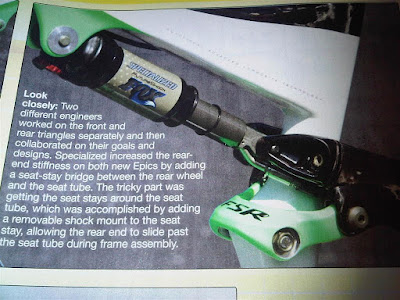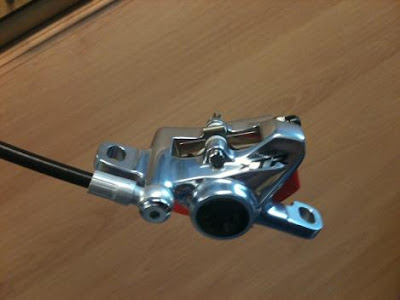Link:
Wednesday, June 30, 2010
Tuesday, June 29, 2010
Monday, June 28, 2010
2011 Specialized Enduro Evo
"Specialized's final clutch of new bikes is the Evo line. These are pumped-up versions of other bikes in the range – there's an Enduro Evo with a Fox DHX coil shock, a Stumpjumper FSR Evo with 150mm travel front and rear, a chain guide, wider bars and bigger tyres, and even an Epic Evo with a 120mm fork. As if that wasn't enough, there are less-is-more race-oriented Evo R variants of the Epic and Stumpjumper HT, with 1x10 drivetrains and custom chainguides"
"What is new for the Enduro is the Evo model, which comes with a Specialized Command Post hydraulic drop seatpost, 750mm wide handlebars, a 170mm Fox 36 Van fork and Fox DHX RC2 coil-sprung rear end"
Links:
Bike Radar
Bike Radar
2011 Lapierre Bikes
Lapierre Froggy:
Refined for 2011
180 mm of rear wheel travel
Both models use 180 mm travel forks
Uses Lapierre's OST suspension system
Internal cable routing for telescoping post
New quick release 12x 142 mm axle
Two models: Froggy 318 and the 518
Available as a frame only
Refined for 2011
160 mm of rear wheel travel
Uses Lapierre's OST suspension system
Internal cable routing for telescoping post
New quick release 12x 142 mm axle
All models use a tapered headtube
Four models: Spicy 516 (pictured), Spicy 316 and 216, and the high end Spicy 916
Lapierre Zesty:
The new Zesty will be launched at Eurobike
Lapierre Zesty:
The new Zesty will be launched at Eurobike
"The Rapt series of dirt jump and trouble making bikes is entirely new for Lapierre in 2011. The Rapt series consists of four models, two aluminum bikes and steel framed bikes, one of each having gears and the other being single speed. All four models come with both front and rear brakes which makes them more versatile than a single braked bike. Throw on some mountain tires and hit the trails! The Rapt 2.1 and 2.2 bikes both use the same integrated seat clamp that is found on the impressive new DH frame."
New series for 2011
Two aluminum models: Rapt 2.1 and the Rapt 2.2 (pictured)
Two steel models: Rapt 1.1 and the Rapt 2.2
Frame only option
Aluminum frames use Lapierre's ABS dropout system to tension the chain
Steel frames feature horizontal dropouts
All models feature ISCG-05 chain guide tabs
All models have derailleur hangers
Links:
2011 Shimano XTR Brakes
"The new one-piece XTR brake calliper (BR-M985) boasts an oversize ceramic piston that is lighter, stiffer and insulates the system from heat better than its predecessor. Maintenance should be easier and quicker thanks to one-way bleeding and improved oil routing, and there's a more powerful Saint-style brake hose, plus its alloy banjo means it should fit a wide variety of frames.
The big change, however, is that under Shimano's new Rider Tuned Technology system you now have a choice of two swanky looking new levers: a super-lightweight pair designed for cross-country racing (BL-M985) or a more powerful and better modulated set aimed at trail riders (BL-M988).
The cross-country option is said to be 40g lighter than current XTR M975, yet 10 percent more powerful. It comes with a choice of resin pads with alloy back plates, or metal pads with titanium back plates. Claimed weight is 215g front / 229g rear (including calliper).
However, if you prize power over gram saving, you can instead team the new compact calliper up with the more robust lever, which features a new short-stroke version of Shimano's Servo-Wave leverage change cam. This brakeset comes with Shimano's new Ice Technologies brake pads, which use finned extensions to pull heat away from the calliper, fluid and rotor.
The trail brakeset also gets slightly wider levers (14mm, compared to 13mm) with a reach-adjust dial. The result of all this is a claimed 25 percent increase in braking power over M975, with no increase in weight. Claimed weight is 247g front / 261g rear.
Both systems get the new Ice Tech rotor, which sandwiches an aluminium core between stainless steel outer layers for improved heat dissipation. This is said to reduce brake fade on long downhills by 65 percent and double pad life, as well as cutting noise and weight. Four sizes are available – 140, 160, 180 and 203mm – with Center Lock mountings only. Claimed weight is 126g (160mm) thanks to use of an aluminium spider. The new discs can be used with any Shimano brake.
Features of both brakesets include:
- Integrated barrel reservoir lever design
- Split clamp for quick installation and removal
- Two-finger lever with ergo pivot and anti-slip dimples
- Clean bleeding by funnel
- Can be used with I-Spec integrated brake/shifter clamp to save weight and free up handlebar space"
Link:
Sunday, June 27, 2010
Saturday, June 26, 2010
2011 Specialized Demo 8
"While the rear dropouts take a wide 150x12mm rear axle, the chainstays and seatstays are narrower for improved heel clearance, with wide, flat-pedal-friendly shoes. At 3in, shock stroke is slightly up on 2010 with a lower leverage ratio. The whole frame is also smoothed out, with potential mud-collecting pockets eliminated. There'll be no Demo 7 for 2011 – it'll be replaced by a new 180mm travel SX Trail."
Link:
bike radar
bike radar
New Specialized Camber
"It's a 120mm travel trail bike (or 100mm in its 29in incarnation) that will occupy a range of price points starting below the Stumpjumper FSR range, but overlapping with it – the top-end Camber will be more expensive than the entry-level Stumpjumper. The Camber is similar to the Stumpjumper in terms of geometry, but in a shorter-travel package. The all-aluminium frame uses integrated hydroforming, with the pivot locations being formed with the tubes rather than being separate welded-in forged sections. You also won't find any Brain shocks – Camber is all about simplicity."
2011 Scott 949
"Scott 949 Scale 29er hardtail, the bike that claims to be the lightest production 29er frame in the world at a maximum weight of 949 grams"
First Ride Review fom Bike Radar here
First Ride Review fom Bike Radar here
Link:
2011 Mongoose Salvo Elite & Teocali Super
Salvo Elite
-floating suspension system
-light & low leverage ratio
-95-120 mm adjustable travel
-floating suspension system
-light & low leverage ratio
-95-120 mm adjustable travel
Teocali Super
-lighter, stiffer rear end
-new shaped hydroformed top tube
-tapered head tube
-gravity dropper
-150mm rear travel
-new shaped hydroformed top tube
-tapered head tube
-gravity dropper
-150mm rear travel
Link:
Friday, June 25, 2010
2010 FireEye Flame
Material: 4130 cromoly (Hydro Formed down tube)
Frame sizes: S,M, L
Suggsted fork travel: 130-150mm
BB size: 68mm
Frame colors: Black, White, Orange, Green
Hanger type: horizontal (ASP compatible)
Disc brake compatible: standard disc brake mount
Weight: 2700g
Frame sizes: S,M, L
Suggsted fork travel: 130-150mm
BB size: 68mm
Frame colors: Black, White, Orange, Green
Hanger type: horizontal (ASP compatible)
Disc brake compatible: standard disc brake mount
Weight: 2700g
9 speeds hanger option
Link:
2011 Scott 899
From Bike Rumor: "Scott Bicycles has unveiled what is likely the lightest full carbon production mountain bike frame, the 2011 Scale 899.Weighing in at a claimed maximum of 899 grams, the new bike took what they learned from their original Scale (which came in at 970g) and not only made it lighter, but refined the geometry, layout and feel of the bike, too.
First off, the geometry. The 899 has a 20mm longer top tube, a 5mm taller headtube and a 10mm lower bottom bracket height. The headtube is now tapered to 1.5″ at the bottom, so it’ll run the latest lightweight forks, too. On this model, the new tapered Rockshox World Cup SID XX handles front suspension.
The main way Scott dropped weight on the new 899 is by moving from tube-to-tube construction on the old model to increased use of their IMP (Integrated Molding Process) construction technique.
The downtube remains very wide all the way from the headtube to the BB30 bottom bracket. Several changes in the bottom bracket area further improved stiffness and performance while dropping weight. First, the seat tube flares out, which improved stress resistance in Scott’s FEA testing and allowed them to use less material with the wider design. Next, they removed the alloy threaded inserts and used press fit bearings, keeping the frame all carbon. Lastly, the wide downtube reduced frame stresses better than the narrower tube on the prior model.
At the top of the seat tube, they used this trick seat bolt design to replace the clamp. Even the lightest collars/bolts are about 16g, and this design is 5g, saving them 11g.
With a 200kg load on the seatpost (and when you hit a bump, you’re putting far more than that amount on your bike, even if you’re a lightweight), Scott measures rear axle deformation (ie. vertical movement) at 4.66mm, which is about 1mm more than the prior Scale. The Tubular Structure assembly is also 25g lighter and 10% more laterally rigid, according to Scott.
Further weight was removed via the direct mount brake system in the rear, and by going to internal cable routing, they removed all the alloy guides, screws and parts that added up to about 47g. The plastic cable guide on the bottom bracket’s exterior and four bottle cage bolts only contribute 11g for a savings of 36g from previous Scale.
The bike shown here was for demo purposes and not built to actual spec. The actual production Scale 899 will be spec’d with DT Swixx XCR 100 carbon fork, DT Swiss hubs and carbon rims, Selle Italia saddle and Scott Pilot SL handlebar and stem. All other spec is as shown, except the tires will be Furious Freds, not Rocket Rons.
MSRP TBD, and there will be three models using this top of the line frame with Scott’s new HMX Net carbon fiber, called the Scale 899, Scale Premium (with 2011 XTR) and Scale RC. Below that, there’s the Scale 10, 20 and 30 that get the HMF Net carbon fiber which is slightly heavier and less stiff (just slightly). Lastly, there will be a Scale 70 with a lightweight alloy frame.
Want more? The 29er version gets unveiled this weekend…which is called the 949. Guess what it weighs?"
Link:
Subscribe to:
Posts (Atom)



















































